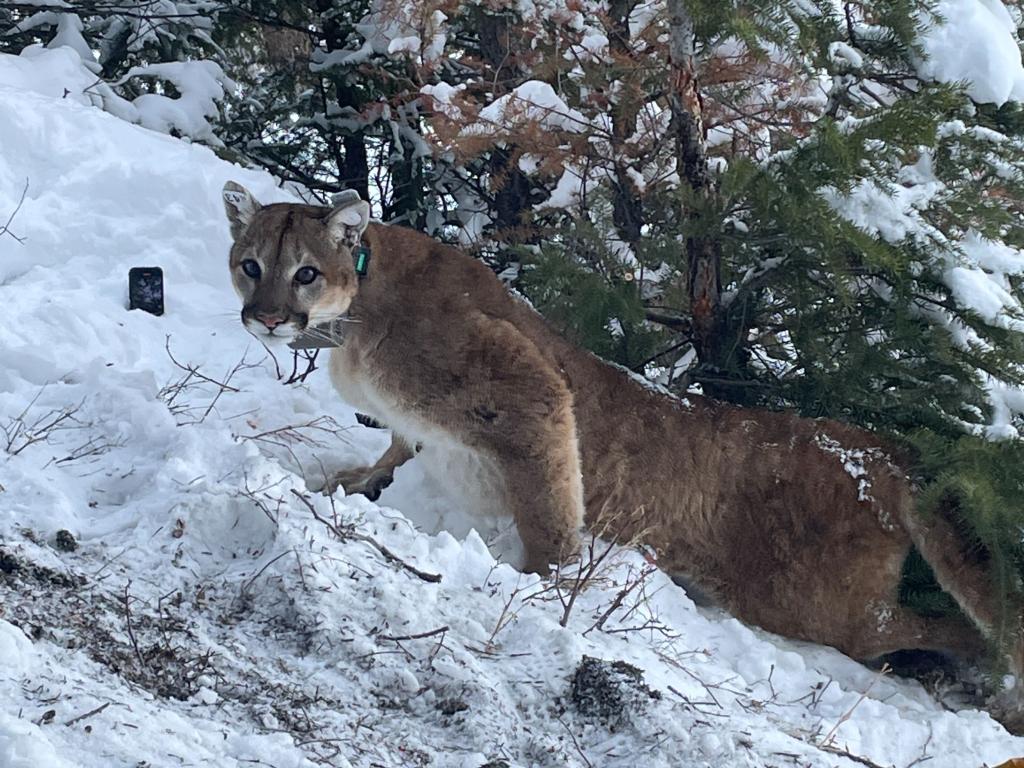Results announced from first two areas of Western Slope Mountain Lion Density Study


John Livingston
Southwest Region Public Information Officer
970-759-9590 / [email protected]
@CPW_SW
Rachael Gonzales
Northwest Region Public Information Officer
970-773-8587 / [email protected]
@CPW_NW
Nov. 12, 2024
DENVER — Colorado Parks and Wildlife has completed analyzing data from a multi-year effort to measure the density of mountain lions in western Colorado. Data confirmed a robust mountain lion population and, in some areas, exceeded modeled estimates.
“We were satisfied to see that our measured estimates of lion density from our winter field seasons are equal to, and in some cases higher than, the lion density projections we use when making harvest management decisions,” said Mark Vieira, CPW’s Carnivore and Furbearer Program Manager. “Data confirmed that current management is meeting agency goals of providing opportunity while managing for healthy and robust populations.”
This effort began in 2020 with a study area in Middle Park, between Kremmling and Granby. That was followed by a second study area in the Gunnison Basin that began in 2021. As part of the West Slope Mountain Lion Management Plan that was approved by the Parks and Wildlife Commission in 2020, CPW committed to initiating a series of studies aimed at estimating how many independent – adult and subadult – mountain lions live in different habitat types and areas of the Western Slope.
“These study areas were selected to be representative of Colorado’s lion habitat with balanced habitat types, landownership and lion harvest levels,” Vieira said.
WATCH: Check out this video on the Western Slope Mountain Lion Density Study (see below).
Numerous CPW staff, including wildlife biologists, district wildlife managers and researchers, invested hundreds of hours to capture, mark, collar and monitor lions as well as to deploy cameras to collect data. In all, CPW marked or collared 48 mountain lions in the Middle Park study area and just over 50 in the Gunnison Basin.
After two years of collection in each of the study areas, an analysis of the data was completed by a CPW staff biometrician, a statistician who uses mathematics to analyze biological data.
Results of the camera-based mark-resight estimates in Middle Park averaged 2.5 independent lions per 39 square miles during the winters of 2021-22 and 2022-23.
In the Gunnison Basin, CPW observed an average density of 4.2 independent lions per 39 square miles in the winters of 2022-23 and 2023-24.
Staff estimated mountain lion density using camera-based mark-resight estimates, a wildlife management technique used to estimate the population size of animals in a specific area. The use of motion-activated cameras to “mark” and “resight” animals over time allows researchers to make informed estimates of population density and trends.
In the mark phase, CPW biologists placed ear tags and GPS collars on mountain lions to create a sample of “marks.” In the resight phase, the trail cameras match with call boxes and record photos of animals. By identifying how many marked individuals are seen in the photos and combining that with photos of unmarked individuals, researchers can estimate the total population size in the study area using mathematical models. Lastly, GPS collar location information is used to account for lions that move on and off the study area during the resighting period.
Through a better understanding of the population density, CPW can make even more informed management decisions based on science.
“These results show that the lion populations in these representative study areas are strong,” Vieira said. “This combination of GPS collars and ear tags on lions paired with trail cameras across large representative study areas is showing us that parts of Colorado appear to have high lion numbers compared to studies of lions in other states.”
As part of the continuing commitment of the West Slope Lion Plan to monitor mountain lion populations, CPW initiated an additional study area during the 2023-24 winter in the Book Cliffs north of Grand Junction and plans to begin lion capture work on a fourth study area east of Durango this winter.
Photo Information
A paw measurement is taken on a mountain lion as part of the Western Slope Mountain Lion Density Study.

CPW staff work to obtain measurements, health assessments and place GPS collars on mountain lions.


Mountain lions collared as part of the study are recaptured on trail cameras near call boxes.


Video:Western Slope Mountain Lion Study
Video: Western Slope Mountain Lion Study
Colorado Parks and Wildlife (CPW) biologists are using the latest technology to better understand mountain lion numbers on Colorado's Western Slope. This long-term research project began in Middle Park in 2021, and it will continue throughout western Colorado over the next 10 years. This video provides an intimate look into this ambitious conservation effort to better understand these large, elusive cats.
Colorado Parks and Wildlife (CPW) is an enterprise agency, relying primarily on license sales, state parks fees and registration fees to support its operations, including: 43 state parks and more than 350 wildlife areas covering approximately 900,000 acres, management of fishing and hunting, wildlife watching, camping, motorized and non-motorized trails, boating and outdoor education. CPW's work contributes approximately $6 billion in total economic impact annually throughout Colorado.
DISCLAIMER: The Colorado Parks and Wildlife (CPW) website maintains press releases containing historical information that may no longer be accurate. Press releases are dated, which should be noted to determine whether the information provided is current. Please review our current regulations and brochures for up-to-date information.